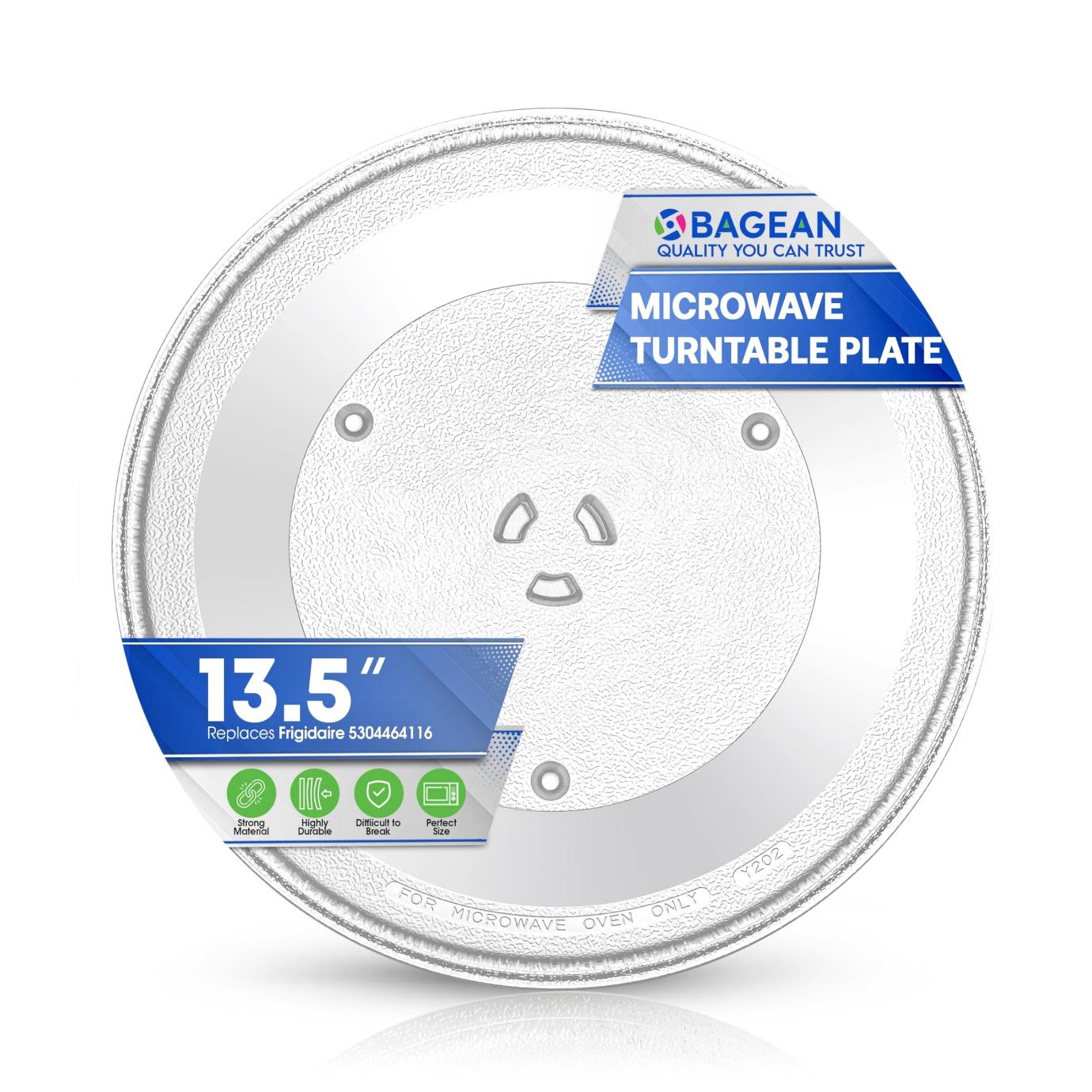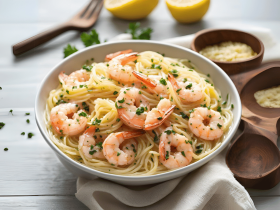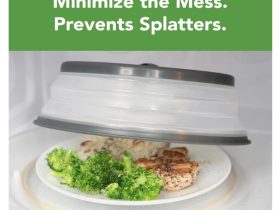Microwaving meals can often result in unevenly heated food, with some parts piping hot and others still cold. A pizza fresh microwave reheating tray or a microwave pizza reheater tray addresses this issue by distributing the microwave energy more uniformly. These trays typically feature a conductive material that enhances the microwaves’ interaction with the food, making them ideal for foods like pizza.
This design ensures that heat reaches different areas of the food more consistently. Many trays also come with raised surfaces or ridges, which allow for better air circulation and can contribute to a more even temperature distribution. By using a microwave reheating tray, you can enjoy leftovers that taste freshly made, as it helps retain moisture and flavor during the reheating process. This kitchen accessory is a must-have for anyone looking to simplify their meal prep and reduce food waste.

Credit: www.amazon.com
Introduction To Microwave Reheating Tray
Many people use microwaves to make their food hot again, but not everyone knows about the convenience of a microwave pizza reheater tray or a general microwave reheating tray. These trays help in heating food evenly. They are special because they make sure every part of your food gets warm. Let’s dive into why these trays are useful and how they benefit us.
Purpose Of Microwave Reheating Tray
Microwave trays have a simple yet important job. They help heat food better. Without them, some parts of your food might stay cold. Here are some key points about their purpose:
- Spread heat evenly: They make sure heat reaches every part of your food.
- Keep food moist: They prevent your food from drying out.
- Safe to use: Made from materials that are safe in microwaves.
- Easy to clean: You can wash them easily after use.
Reheating Specific Foods
For certain foods, like Chick-fil-A mac and cheese trays, reheating requires a bit of extra attention. To reheat a Chick-fil-A reheatable tray, make sure you follow any specific instructions to maintain texture and flavor. These reheatable trays are convenient and ideal for quick meals.
Benefits Of Using Trays
Using microwave trays brings many good things. Here’s why they are so helpful:
- Save time: Your food heats up faster, so you wait less.
- Better taste: Food tastes better because it heats up evenly.
- Less mess: They contain spills, keeping your microwave clean.
- Reusable: You can use them many times, which saves money.

Credit: www.walmart.com
Types Of Microwave Reheating Tray
Everyone loves a hot meal, but no one likes waiting. A pizza fresh microwave reheating tray or microwave pizza reheater tray makes it quick and easy. They come in many shapes and sizes. Let’s explore the different kinds and their special features.
Material Variations
The right material can make all the difference in heating food. Here are some common materials used:
- Plastic Trays: Lightweight and often cheaper. Look for BPA-free labels.
- Glass Trays: Great for even heating. They are also easy to clean.
- Silicone Trays: Flexible and perfect for small microwaves.
- Metal Trays: Not common, as metal is usually not microwave-safe.
- Ceramic Trays: They hold heat well, keeping food warmer for longer.
Each material has pros and cons. Think about your needs before choosing. Here’s a quick table to help you decide:
| Material | Pros | Cons |
| Plastic | Cheap, Light | May stain or warp |
| Glass | Easy to clean, Even heating | Heavier, Can break |
| Silicone | Flexible, Fits anywhere | May retain odors |
| Ceramic | Keeps heat, Durable | Heavy, May crack |
Design Features
Trays can have cool features to help you more. Here’s what to look for:
- Compartments: Keep different foods separate.
- Lids: Stop splatters and keep moisture in.
- Handles: Make it easy to take hot trays out.
- Stackable: Save space in your kitchen.
- Venting Systems: Let steam out and prevent soggy food.
Designs can change how well trays work. Some have ridges on the bottom. This helps air move and heats food evenly. Others are flat and simple. They work well for pizza or sandwiches. Below is a table that shows these features.
| Feature | Benefit |
| Compartments | Food stays separate |
| Lids | Less mess, Better taste |
| Handles | Safe to handle |
| Stackable | Saves space |
| Vents | No soggy food |
How Microwave Reheating Tray Work
Many of us use microwaves to warm our food quickly. Microwave reheating trays make this process even better. They are designed to heat food evenly, without cold spots. Let’s explore how these trays work and improve our microwaving experience.
Heat Distribution
Even heating is key to a tasty reheated meal. Microwave trays come with special features for this:
- Materials: They use substances that spread heat well.
- Design: Shapes and ridges on trays guide heat to all parts of the food.
- Waves: Trays can focus microwave energy for better cooking.
Some trays also use conductive wires or metals. These parts get hot fast and send heat to your food. This makes for a hot meal, just like when it was first cooked.
Let’s look at a simple table to see how different trays stack up:
| Tray Type | Heat Distribution | User Rating |
| Flat Tray | Good | 4/5 |
| Ridged Tray | Better | 4.5/5 |
| Tray with Metal | Best | 5/5 |
Microwave Interaction
Microwave ovens work by sending out waves. These waves make water in food move and heat up. Microwave trays change how these waves move. They help the waves reach more of the food. This is how they work:
- Reflection: Some trays have smooth parts that bounce waves around.
- Absorption: Other trays soak up waves and heat up themselves.
- Pass-Through: Special designs let waves go through and cook food from below.
These trays can make our microwaves work better. They turn microwaves into an oven that heats all over. Foods like pizza or lasagna come out hot and yummy all through.
By using a tray, we can stop parts of our meal from getting too hot or staying cold. It’s smart to pick a tray that works well with our microwave. A good tray can make sure every bite is just right.

Credit: www.walmart.com
Choosing The Right Microwave Reheating Tray
Choosing the right microwave reheating tray is important for your kitchen. This guide helps you pick the best one. We talk about size and material. Both are key to making your food taste great and keeping you safe.
Size Considerations
Finding the perfect size tray is like picking the right shoes. Too small, and your food won’t fit. Too big, and it won’t rotate in the microwave. Here’s what to think about:
- Measure your microwave: Use a tape measure to find the inside width and depth. This tells you the biggest tray you can get.
- Think about your dishes: What do you heat up often? Big casseroles need bigger trays.
- Storage is key: Big trays eat up space. Make sure you have room to store them.
Most trays come in a few standard sizes:
| Tray Size | Best For |
| Small (10-12 inches) | Single servings, small dishes |
| Medium (13-15 inches) | Family meals, medium dishes |
| Large (16 inches and up) | Large casseroles, big meals |
Material Selection
The tray’s material makes a big difference. Some are safe, some are not. Here’s a quick guide:
- Glass: Safe and easy to clean. Works well for most foods.
- Plastic: Must be microwave-safe. Look for the label. Avoid if you can.
- Silicone: Flexible and safe. Good for baking and reheating.
- Ceramic: Heavy but heats evenly. Make sure it’s microwave-safe.
- Metal: A big no. It sparks and is dangerous in microwaves.
Each material has pros and cons:
| Material | Pros | Cons |
| Glass | Non-toxic, easy to clean | Can break if dropped |
| Plastic | Lightweight, cheap | May release chemicals |
| Silicone | Flexible, non-stick | Can retain odors |
| Ceramic | Even heating, durable | Heavy, can crack |
| Metal | None | Unsafe for microwaves |
Tips For Effective Reheating
Everyone loves a hot meal. But, reheating food in a microwave can be tricky. Sometimes it comes out unevenly heated or too dry. Using a microwave reheating tray can help. It makes sure your leftovers get warm just right. This guide will show you how to do it best.
Layering Food
Putting food in layers helps it warm up evenly. Think of it like dressing in winter. You wear layers to keep warm all over. Here are some tips:
- Thin layers work best. They let the heat move through easily.
- Start with the heaviest food at the bottom and lighter food on top.
- Spread food out. Don’t pile it up in the middle.
Imagine you’re heating up a dinner plate. You might put rice, then chicken, then veggies. Each layer gets heat without blocking the others.
Using Lids
Covering food when you reheat it does wonders. It keeps the moisture in, so your food doesn’t dry out. Here’s how to do it:
- Use a microwave-safe lid or a microwave-safe plastic wrap. Make sure it’s not tight. You want steam to escape.
- Leave a small opening for steam to get out. This stops food from getting soggy.
- For soups or liquids, cover them but stir halfway through. This helps heat them evenly.
Remember, using lids isn’t just about keeping food moist. It also helps heat your food evenly and quickly. So, next time, try covering your plate. You’ll see the difference!
Common Mistakes To Avoid
Reheating food in a microwave is quick and convenient. Using a microwave reheating tray can make it even easier. But, some common mistakes can ruin your meal. Knowing what to avoid ensures your food stays tasty and safe.
Wrong Materials
Not all materials are safe for microwave use. Some can melt or cause fires. Others can release harmful chemicals into your food. To stay safe, always use microwave-safe trays and containers. Here’s what to avoid:
- Metal objects: They can cause sparks and fires.
- Plastic take-out containers: These might melt and leach chemicals.
- Styrofoam: It can melt and is not safe for your health.
Check for a microwave-safe label on your tray or container. If in doubt, transfer food to a dish you know is safe.
Overcrowding
Putting too much on your tray can cause uneven heating. Some parts may be hot while others stay cold. This is not good for taste or safety. Here are tips to avoid overcrowding:
- Arrange in a single layer: This helps heat reach all parts evenly.
- Leave space between items: It allows microwaves to circulate better.
- Heat in batches: If you have a lot to warm up, do it in smaller amounts.
Remember, food needs room to heat properly. Give your dishes the space they need in the microwave.
Cleaning And Maintenance
Microwave reheating trays make warming food quick and easy. Keeping them clean ensures they work well and last long. Proper cleaning and maintenance are key. This guide will show you how to care for your tray correctly.
Best Practices
Caring for your microwave reheating tray involves simple steps. Always check the manufacturer’s instructions before cleaning. Use the right cleaning agents to keep the tray in top shape. Here’s what you should do:
- Let the tray cool before washing to prevent warping.
- Use warm, soapy water and a soft sponge or cloth.
- Rinse with clean water and dry thoroughly to avoid water spots.
- For stuck-on food, soak the tray in warm, soapy water before scrubbing.
- Avoid abrasive cleaners which can scratch the surface.
Remember to clean the tray after each use. This prevents build-up and keeps the tray ready for next time.
Avoiding Damage
To prevent damage to your microwave reheating tray, certain things should be avoided. Mishandling can lead to cracks or even breakage. Follow these tips to keep your tray safe:
- Do not use in a conventional oven. The tray is for microwave use only.
- Avoid sudden temperature changes, like moving from freezer to microwave.
- Do not cut food directly on the tray to prevent scratches.
- Never use metal utensils as they can cause damage.
- Be careful not to drop or hit the tray against hard surfaces.
By following these tips, your tray will stay safe from common types of damage.
Innovations In Microwave Trays
The microwave reheating tray is a kitchen wonder. It warms up food fast and evenly. People love it because it’s easy to use. Plus, new trays have cool updates. They make warming food even better.
Smart Features
Today’s microwave trays are not like the old ones. They have features that are very clever. Some trays can change how hot they get based on the food. This means your pasta gets hot but not too hot. Here are some cool things these trays do:
- Temperature control: Adjusts heat for different foods.
- Timer settings: Tells you when your food is ready.
- Moisture lock: Keeps your food from getting dry.
These features help in many ways. Your food tastes like it was just made. You don’t have to guess the time. The food stays juicy and delicious.
Eco-friendly Options
People also care about our planet. They want products that are good for Earth. Microwave trays are now made with this in mind. Some are made from materials that don’t harm the environment. Here’s what makes them special:
| Feature | Description |
| Biodegradable materials | Made from stuff that goes back to the earth. |
| Recycled plastics | Uses old plastics to make new trays. |
| Reusable designs | Can be used many times, not just once. |
These options are great for everyone. They keep the planet safe. You can feel good using them. Your food is hot and tasty. Plus, you are helping the earth.
Frequently Asked Questions
Microwave reheating trays can significantly reduce warming times. They distribute heat more evenly, leading to quicker, more efficient reheating compared to using microwave-safe plates or bowls.
Most microwave reheating trays are made of microwave-safe materials like plastic, glass, or silicone. They’re designed to withstand high temperatures without melting or leaching chemicals into food.
Generally, microwave reheating trays are universal. However, ensure the tray fits your microwave’s size and is compatible with its turntable or flatbed design for best results.
Most trays are dishwasher-safe. If washing by hand, use warm soapy water and a sponge. Avoid abrasive cleaners to prevent scratching the surface.























Leave a Reply